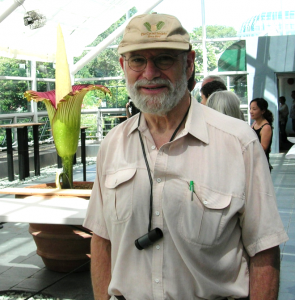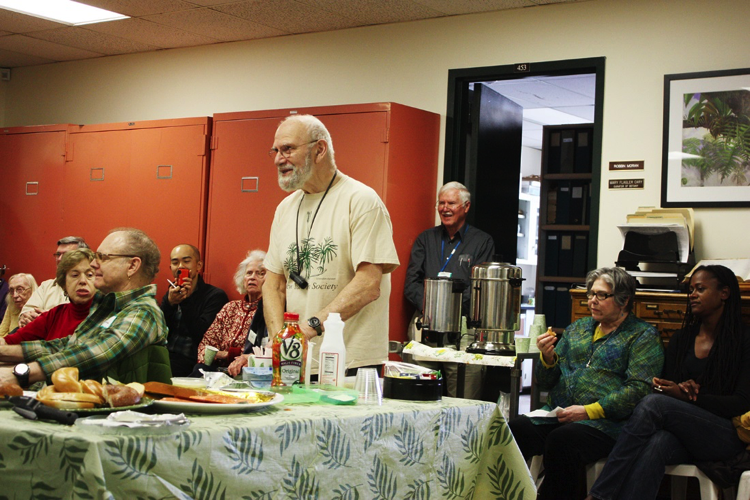Oliver Sacks: A Remembrance
Posted in Personalities in Science on November 25, 2015 by Robbin Moran
Robbin C. Moran, Ph.D., is Nathaniel Lord Britton Curator of Botany at NYBG‘s Institute of Systematic Botany. He is an expert on ferns and lycophytes.

Oliver Sacks, a board member of The New York Botanical Garden, died of cancer at his home in New York City on August 30, 2015. He was 82. Oliver was one of the world’s leading neurologists and science writers, known for his many essays and books such as Awakenings, The Man who Mistook his Wife for a Hat, An Anthropologist on Mars, Island of the Colorblind, Uncle Tungsten, and Musicophilia. Some of these books, or chapters in them, were adapted for film and/or stage, such as Awakenings (Robin Williams and Robert De Niro), At First Sight (Val Kilmer and Mira Sorvino), and The Music Never Stopped (Lou Taylor Pucci and Julia Ormond). Since his death, much has been written about his life, but little has been written about him as a lover of plants, which he indeed was, especially of ferns and cycads.
Oliver developed an interest in plants as a boy. At age six he was evacuated from London to a school in the English Midlands to avoid the Blitz. Separated from his parents and extremely lonely and unhappy, he took solace in holiday visits to his Aunt Len’s place in Cheshire. She had a garden and delighted in explaining its plants to an inquisitive young Oliver. They took long botanizing walks in the forest, stopping frequently to look at ferns and horsetails. These visits to “Auntie Len’s” instilled a love for plants that stayed with him for the rest of his life.
For 23 years Oliver regularly attended the monthly meetings of the New York Fern Society. The meetings take place at the New York Botanical Garden in an area just outside my office. He usually wore baggy pants, a Fern Society T-shirt, and a green baseball cap with the Garden’s logo. Before and after the meetings he would come into my office to talk about plants and minerals (another interest we shared). I once showed him a herbarium specimen of a clubmoss (Huperzia) that I had identified from Madagascar. The particular species was smoked by the local population for its narcotic effects. Oliver, a neurologist and noted experimenter with these substances (especially in his earlier days; see his book On the Move), asked me sheepishly if he could have a piece of the clubmoss to experience for himself. I declined, telling him that the specimen could not be used for such purposes and, besides that, I felt uncomfortable with him experimenting with drugs. He laughed and did not seem at all upset.
One of Oliver’s lesser-known books, Oaxaca Journal, is about a 10-day fern foray to Oaxaca, Mexico, during January 2000. The trip was organized by myself and John and Carol Mickel through The New York Botanical Garden. Oliver told me that he was looking forward to seeing in Oaxaca the Tule tree, a humongous bald cypress (Taxodium mexicanum) visited by Alexander von Humboldt in 1803, who thought it might be 4,000 years old. Oliver learned about the tree as a child because it was depicted in his copy of Strasburger’s Textbook of Botany, and later in life he had read about the tree in Humboldt’s travels. This incident exemplified how well-read Oliver was. On several occasions I told him about recently published books he might enjoy reading, such as David Lee’s Nature’s Palette, and Daniel Chamovitz’s What a Plant Knows. In all cases Oliver had either read the book already or knew the author and/or had “blurbed” the dust jacket.
Oliver was a compulsive writer. When I picked him up at the airport in Oaxaca, he was standing at an airline check-in counter writing hurriedly in a small notebook. Felt pens of different colors stuck out of his mouth, each color (as I later learned) used to denote various subjects such as green for plants, black for philosophy, red for cultural features. He was recording a conversation with a man seated next to him on the flight from Mexico City. That conversation was the beginning of what was to become the Oaxaca Journal. During the Oaxaca tour, I often had breakfast with him, and he would read aloud to me what he had written about previous day’s events. Much of what he read is exactly as it appears in the Oaxaca Journal. He had an extraordinary ability to write a very good first rough draft.

I learned to be circumspect about what I told Oliver. He recorded nearly everything, even if off-color or personal. On the Oaxaca trip, while John Mickel was animatedly and excitedly explaining the field characteristics and virtues of a fern, I remarked to Oliver that “John is having a pteridological orgasm.” That comment found its way into Oaxaca Journal. Similarly, Oliver once accompanied me to the La Selva Biological Station in Costa Rica where I was teaching a course, Tropical Plant Systematics, sponsored by the Organization for Tropical Studies. I told him about two students who took my first course in 1998 and got married two months later in a tree at the biological station (one of them was a canopy researcher). Later, while Oliver was recording this story in his notebook, the very student who got married walked by and introduced himself. Oliver replied, “I was just writing about you!”
In his apartment Oliver cultivated a whisk fern (Psilotum), horsetail (Equisetum), and assorted ferns. He enjoyed pointing them out to visitors, explaining how they dispersed and reproduced by liberating spores, and how the whisk fern, at least superficially, resembled some of the earliest vascular plants that first colonized the land. He especially delighted in hearing about adaptations of ferns, the fossil history of ferns, and their uses by people. He kindly wrote a foreword for my book, A Natural History of Ferns, which covered these topics and others.
In 2005 Oliver developed a rare form of melanoma in his right eye. Although treated, he eventually lost color vision and then all sight in the eye (read his account in The Mind’s Eye). Tragic as this was, the melanoma, at least, seemed defeated. Things were fine until January 2015. While attending a meeting of the New York Fern Society, he got up to use the bathroom and noticed a discoloration of his urine. After seeing his physician, he learned that this was caused by the eye cancer having metastasized to his liver, and it was estimated he had less than a year to live. Within a few days, he was back to writing. He published several essays about his terminal cancer and thoughts on life in the New York Times. These essays have been collected in a book called Gratitude, whose title sums up Oliver’s overwhelming feeling about his own gift of life. The essays are well worth the read for their insight and wisdom. “Above all,” he wrote, “I have been a sentient being, a thinking animal, on this beautiful planet, and that in itself has been an enormous privilege and adventure.”
This article first appeared on Botanical Electronic News, November 17, 2015.

